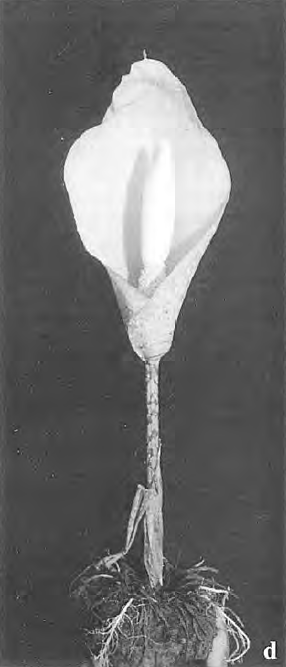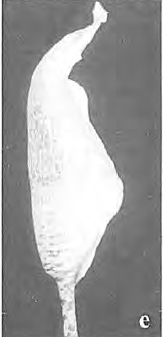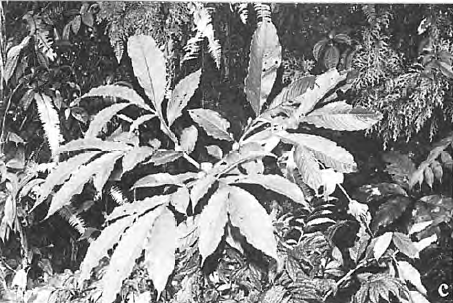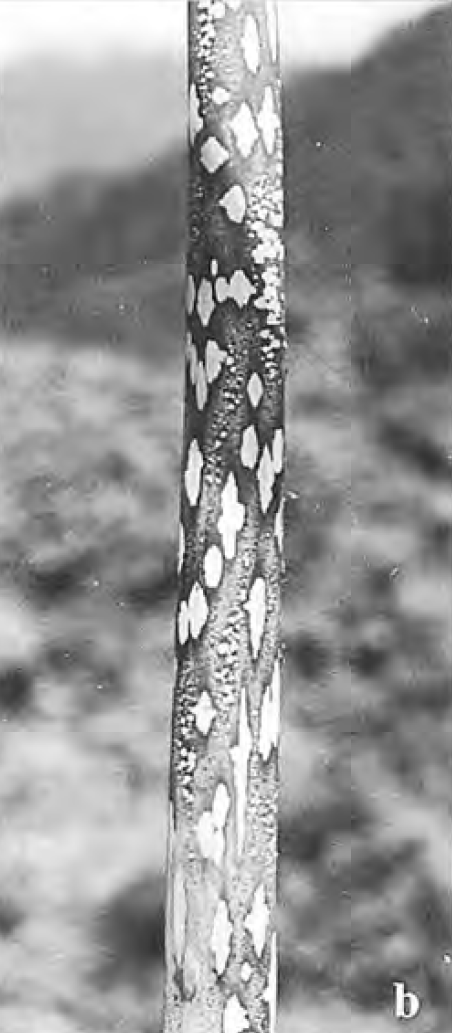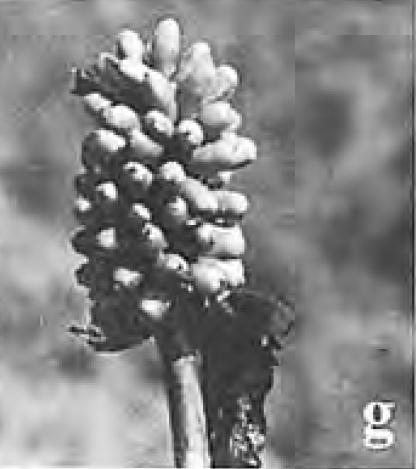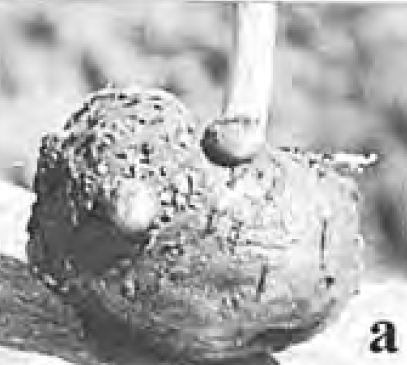AMORPHOPHALLUS BOGNERIANUS
ORIGINAL DESCRIPTION:
Amorphophallus bognerianus Sivad. & Jaleel sp. nov.
Amorpbopballus bulbifer (Sims) Blume affinis, sed inflorescentiis curte pedunculatis, spathis spadicibus longioribus, spatholimbis apice cucullatis, spadico-appendicibus spadico-fecundopartibus in longitudinem plus minusve aequalibus differt.
Type: INDIA, Arunachal Pradesh, Bhalukpong, alto 217 m, 8th June 1999, Abdul faleel RIA 371 (Holo-K).
SYNONYMS:
HOMOTYPIC SYNONYMS: N/A
HETEROTYPIC SYNONYMS: N/A
ACCEPTED INFRASPECIFICS: N/A
DISTRIBUTION: India | East Himalaya
To this time known only from the type locality in Arunachal Pradesh; endemic. Specimens examined: Arunachal Pradesh, Bhalukpong, alto 217 m, 2nd October 1997, Abdul faleel RIA 199 (leaf) (CALI); Ibid., 2nd October 1997, Abdul faleel RIA 200 (infructescence.) (CALI); Kerala State, Calicut University Botanical Garden, 13th May 1999, Abduljaleel RIA 370 (infl.) M; Ibid., 8th June 1999, Abdul faleel RIA 371 (infl.) (CALI) (originally collected from Bhalukpong, Arunachal Pradesh and introduced in the Calicut University Botanical Garden).
CLIMATE: N/A
ECOLOGY: N/A
SPECIES DESCRIPTION:
Tubers depressed globose, ca. 9 cm in diam. and ca. 4.5 cm thick in reproductive phase, 7-14.5 cm in diam. and 4.5-10.5 cm thick in vegetative phase, skin light brownish; roots many, pale yellow in colour, 8-14 cm long, and ca. 0.2 cm in diam. Leaf trichotomously decompound; petiole smooth, 77-105 cm long, 1.5-3.8 cm in diam. at base, tapering towards tip, dark greenish with pale green, irregular, ovoid to oblong horizontal mottles, minute pale green lines also seen within the mottles, colour paler towards the tip, extreme base pale pink; Lamina 60-90 cm in diam., middle segment of rachis 7-11.2 cm long and lateral segments 4-8 cm long; leaflets oblong to elliptic, acuminate at apex, base unequal and decurrent on rachis, margin wavy, greenish above, paler beneath, varying in size, small leaflets 6-10 cm long and 3-5.2 cm broad, large leaflets 2026 em long and 5.5-8.0 cm broad; primary veins closely parallel and united below the margin forming a submarginal collective vein. Bulbils produced at the junction of the rachises and at axils between the rachises and their branches, brown in colour, subspherical, each 0.6-3.5 cm diam. and 0.5-1.5 cm thickness.
INFLORESCENCE:
Inflorescence with peduncle short, cylindric, smooth, 11.0-15.5 cmlongandO.7- 0.9 cm in diam. at base, gradually narrowed to tip, identical with the petiole in colour and pattern of mottles; Spathe broadly lanceolate, 13.0-25.0 cm long, differentiated into a basal convolute tube and an upper expanded limb, without constriction in between; convolute basal tube apically dilated, funnel-shaped, 2.02.6 cm in diam. at base, 3.5-4.0 cm diam. at top; limb 8.5-13.0 cm broad at the centre, tip acute and cucullate, pale pinkish outside, with narrow horizontal brownish green patches at basal convolute part, the patches vertical on the limb portion, and brownish green mottles towards the tip, pinkish inside with minute murications at base, smooth and paler above. Spadix subsessile, shorter than the spathe, 9.513.0 cm long; stipe 0.2-0.3 cm long, .6.9 cm in diam., pale pinkish; basal pistillate portion 2.5-2.9 cm long, 1.2-1.7 cm in diam., followed by a staminate portion 2.1-2.5 cm long, 1.2-1.7 cm in diam., and terminal fusiform appendix. Female flowers densely arranged, each flower 2.5- 3.0 mm long, ovary ca. 1 mm long, 2- 2.5 mm diam., spherical, dark reddish, one or two-locular, each locule with a single anatropous ovule; style very short, ca. 1.0 mm long, 1.5-2.0 mm in diam., colour same as that of ovary; stigma discoid, 2- or 4-lobed, ca. 2.5 mm in diam. Male flowers closely arranged, ca. 3 mm long, ca. 2 mm broad, cream-coloured, dehiscence by apical confluent pores. Appendix fusiform, 4.5-7.5 cm long, base 1.2-1.7 cm in diam., 1.5-2.0 cm at middle and gradually tapering to a rounded tip, yellow in colour with slight brownish, minute spinescent projections at maturity, especially towards the tip. Fruits elongate-ellipsoid, 1.5-1.7 cm long, ca. 0.7 cm in diam. Seeds 1.1-1.2 cm long and ca. 0.5 cm in diam. Flowering: May-June. Fntiting: August-September.
VARIEGATED FORMS: N/A
ETYMOLOGY: The species is named in honour of Dr. Josef Bogner (1939-2020), formerly of the Munich Botanical Garden, Germany for his invaluable contribution to the field of aroid study and for his generous, whole-hearted and selfless help rendered to the aroid scientists and aroid enthusiasts worldwide. He was an individual who has devoted his life to the study of aroids and for aroid scientists.
NOTES: Amorphophallus bognerianus is related to Amorphophallus bulbifer but differs in having an inflorescence with a short peduncle and an erect, apically cucullate limb. It also differs from Amorphophallus bulbifer in having the spadix appendix more or less equal in length to the fertile portion of the spadix. In Amorphophallus bulbifer, the spadix more or less equals the length of the spathe, and the limb of the spathe is fully expanded and erect at maturity. In Amorphophallus bognerianus, the spathe is much longer than the spadix.
The plant was collected in both fruiting and vegetative phases during September 1997, and from the corms planted in the Calicut University Botanical Garden, which flowered during May–June 1999.
In India, there are a total of 20 species of which Amorphophallus bulbifer, Amorphophallus oncophyllus, and Amorphophallus carnosus are the only three species that produce bulbils. Amorphophallus oncophyllus and Amorphophallus carnosus are confined to the Andaman Islands, whereas Amorphophallus bulbifer occurs in mainland India.
The new species differs from Amorphophallus bulbifer var. marmoratus Engl. (as seen in Wight’s illustration, t. 783, 1844) in having a spadix appendix which is more or less equal in length to the fertile portion of the spadix. In the illustration of Amorphophallus bulbifer var. marmoratus, the spadix appendix was shown to be half the length of the fertile portion. The limb of the spathe was shown to be fully expanded at maturity. In the new species, the apical portion of the limb is more or less vaulted or cucullate, and is not expanded and flat as shown in the illustration of var. marmoratus.
The spathe is more or less equal in length to the spadix in Amorphophallus bulbifer var. atroviridimaculatus Engl. (Curtis’ Botanical Magazine XLVI: t. 2072, 1819), whereas in the new species, the spathe is much longer than the spadix. Additionally, the spathe apex in var. atroviridimaculatus appears to be erect, and not cucullate.
When compared with the illustration of Amorphophallus bulbifer var. tuberculiger (vide Curtis’s Botanical Magazine II: t. 2508, 1824), it is observed that in var. tuberculiger, the spadix is longer than the spathe, and the spadix appendix is more than half the length of the fertile portion. Moreover, the male zone appears to be longer than the female zone. The spathe apex appears to be erect. The descriptions of the above three varieties are not explicit, hence the difficulty in identifying specific diagnostic characters.
CULTIVARS: N/A
HYBRIDS: N/A



